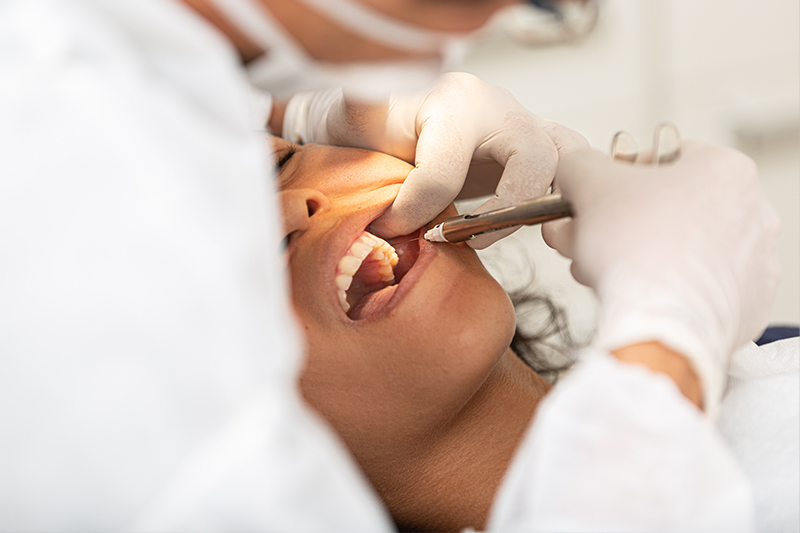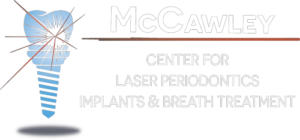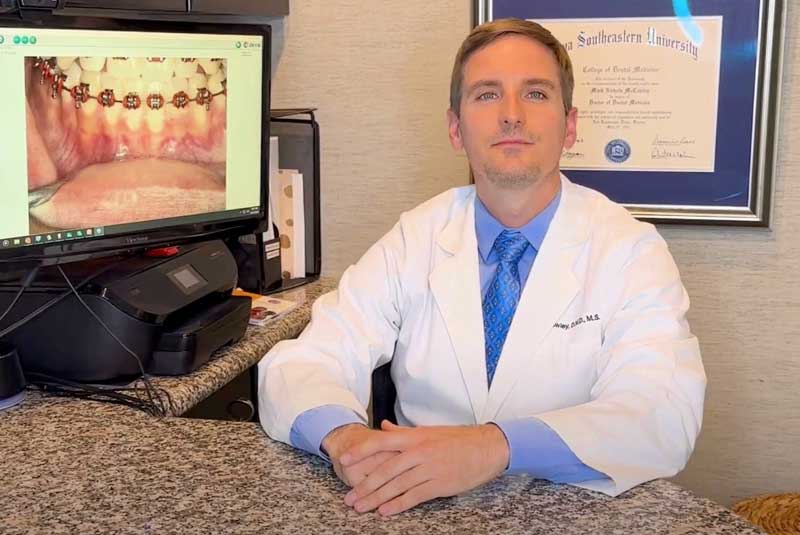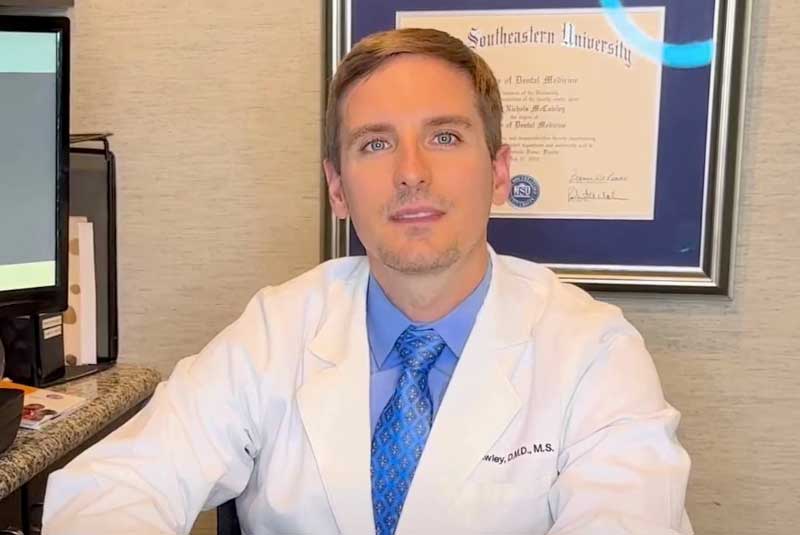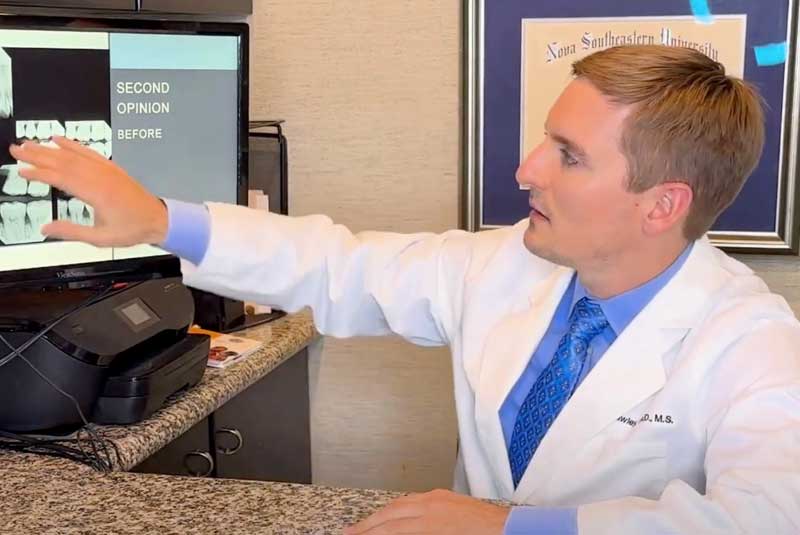| ✅ Reviewed by Dr. Tom McCawley | 🕒 Reading time: four minutes |
Receding gums can be easy to ignore at first. Maybe you have noticed your teeth looking a little longer in the mirror, or you have started feeling more sensitivity when brushing.
But no matter how subtle it seems, gum recession is always a sign that something is going on beneath the surface.
At McCawley Center for Laser Periodontics and Implants in Fort Lauderdale, we specialize in diagnosing and treating the root cause of gum recession, not just the symptoms.
In this blog, we explain what causes receding gums and how our advanced treatments can help restore your gum health.
What Causes Receding Gums?
Gum recession happens when the gum tissue surrounding a tooth pulls back or wears away, exposing more of the tooth root. This leaves the area more vulnerable to decay, sensitivity, and even tooth loss if not addressed.
Periodontal Disease (Gum Disease)
This is one of the leading causes of receding gums. Gum disease includes several forms, the most common being gingivitis and periodontitis.
Gingivitis is the earliest stage and is marked by red, swollen gums that may bleed easily. If left untreated, it can progress to periodontitis, a more serious form of gum disease where harmful bacteria build up below the gumline and trigger inflammation that slowly breaks down the tissue and bone holding your teeth in place.
Our team uses microscopic and culturing techniques to identify the exact bacteria responsible and then target them for removal with precision laser therapy.
Orthodontic Tooth Movement
An important cause of gum recession is orthodontics when the teeth are moved into areas of thin bone and tissue.
Aggressive Tooth Brushing
Brushing too hard or using a stiff-bristled toothbrush can wear away enamel and irritate gum tissue, leading to recession over time. Switching to a soft-bristled toothbrush can help prevent additional damage while still keeping your teeth clean.
Genetics
Sometimes, it is in your DNA. Thin gum tissue or a predisposition to periodontal disease can increase your chances of developing receding gums, even if your oral hygiene is excellent.
Teeth Grinding or Misalignment
Clenching or grinding your teeth puts excess pressure on the gums. Similarly, when teeth are out of alignment, some may bear more force than others, causing localized recession.
Dry Mouth and Tartar Buildup
A persistently dry mouth reduces the natural cleansing effects of saliva, allowing plaque to harden into tartar more quickly. Tartar buildup near the gumline can irritate tissues and lead to gum recession if not removed regularly with professional cleanings.
Tobacco Products
The use of tobacco products is linked to a higher risk of gum disease and recession. Smoking or chewing tobacco impairs blood flow to the gums and makes it harder for your tissue to heal, increasing the likelihood of long-term damage.
Trauma or Previous Dental Work
Gum recession on one tooth often results from trauma or overly aggressive dental procedures in that specific area. Gum recession on one tooth often results from trauma or overly aggressive dental procedures in that specific area.
Stages of Gum Recession
Gum recession typically progresses gradually and is often categorized by how much gum tissue has been lost and how exposed the tooth root is. Here are the general stages:
- Mild gum recession: The gumline begins to pull away slightly from the tooth, but most of the root remains covered. There may be little or no discomfort, though some sensitivity can occur.
- Moderate gum recession: More of the tooth root becomes exposed, and gum tissue loss is noticeable. Patients often experience increased sensitivity to temperature and sweets, along with more visible tooth length.
- Advanced gum recession: A significant portion of the root is exposed, and the supporting bone structure may be affected. This stage often includes loose teeth, deep pockets around the gums, and a higher risk of tooth loss if not treated promptly.
Signs of Gum Recession
Gum recession often develops slowly, which makes it easy to miss in the early stages. Here are some signs to watch for:
- Teeth that appear longer than they used to
- Increased tooth sensitivity, especially to hot, cold, or sweet foods
- Exposed tooth roots
- A visible notch near the gumline
- Gums that feel tender, swollen, or bleed easily when brushing or flossing
- Bad breath or a lingering bad taste in the mouth
If you notice any of these symptoms, it is important to have a dental evaluation. Early detection can help prevent further damage and avoid more complex treatment later.
Why Am I Seeing Gum Recession on Just One Tooth?
This is a common concern, and it is not always linked to poor hygiene. Localized gum recession often points to a few specific culprits:
- Brushing too aggressively in one spot
- A misaligned bite or tooth grinding at night
- An old filling or crown irritating the surrounding gum tissue
- Habits like nail biting or using your teeth to open packages
If you have spotted gum recession on one tooth, it is best to have it evaluated before it spreads or leads to deeper issues such as bone loss.
The McCawley Approach to Treating Gum Recession
While traditional treatments like scaling and root planing (deep dental cleaning) are important for managing the early stages of gum disease, they are not designed to reverse gum recession.
These methods focus on reducing inflammation and controlling infection but do not regenerate lost gum tissue.
In fact, studies have shown that scaling and root planing alone may not significantly reduce harmful bacteria deep within the gum pockets. Even though it remains a widely used nonsurgical treatment for managing early-stage periodontal disease, it may not be enough for more advanced cases.
We are proud to offer the Pinhole Surgical Technique, a minimally invasive option for correcting receding gums without scalpels, stitches, or the need to harvest tissue from the roof of your mouth.
For patients with underlying periodontal disease, our LANAP laser therapy removes harmful bacteria and stimulates tissue regeneration. This helps preserve your natural gum line and can even promote bone growth.
We believe in saving teeth, not removing them. Whether you are dealing with recession on one tooth or multiple, we will help you get to the bottom of it and restore your oral health using the most advanced technology available.
Tips to Prevent Gum Recession
Preventing gum recession starts with everyday habits that protect your oral health and minimize risk factors. Here are some proven strategies:
- Use a soft-bristled toothbrush and avoid aggressive brushing techniques.
- Practice good oral hygiene by brushing twice a day and flossing daily.
- Visit your dentist regularly for cleanings to remove plaque and tartar buildup.
- Stay hydrated to avoid dry mouth, which can increase bacterial activity.
- Follow a healthy diet that supports your immune system and keeps your gums strong.
- Avoid tobacco products, which are linked to higher rates of gum disease.
- Wear a night guard if you grind or clench your teeth.
- Correct bite misalignment with orthodontic treatment if necessary.
Making these habits part of your routine can significantly reduce your chances of developing gum recession.
Worried About Receding Gums? Let Us Help
If something looks or feels off with your gums, do not wait. The earlier we catch gum recession, the easier it is to treat and often, the better the outcome.
To book an appointment at our periodontal office in Ft. Lauderdale, FL, call (954) 807-4829 or visit us at 800 East Broward Blvd #706 Fort Lauderdale, FL.
FAQs About Receding Gums
The best way to stop gum recession is to identify and treat the underlying cause. This may include treating gum disease, improving dental hygiene, addressing bite issues, or using custom night guards to prevent grinding. Early diagnosis is key.
Gum disease is the most common cause of gum recession. The bacteria involved in periodontitis break down the gum and bone tissue that support your teeth, leading to visible recession over time. Orthodontic treatment also is a common cause.
Receded gums do not grow back on their own, but treatments like the Pinhole Surgical Technique or gum grafting can restore the appearance and function of the gumline.
Tooth loss becomes a risk when recession is severe enough to compromise the bone and ligament support around the tooth. Early treatment can help prevent progression and protect your teeth.
Several factors can increase your risk of gum recession, including poor dental hygiene, periodontal disease, orthodontics, aggressive brushing, tobacco use, dry mouth, hormonal changes, misaligned teeth, tongue piercings, and a family history of gum issues. Identifying these risk factors early can help you take steps to protect your gum health.

